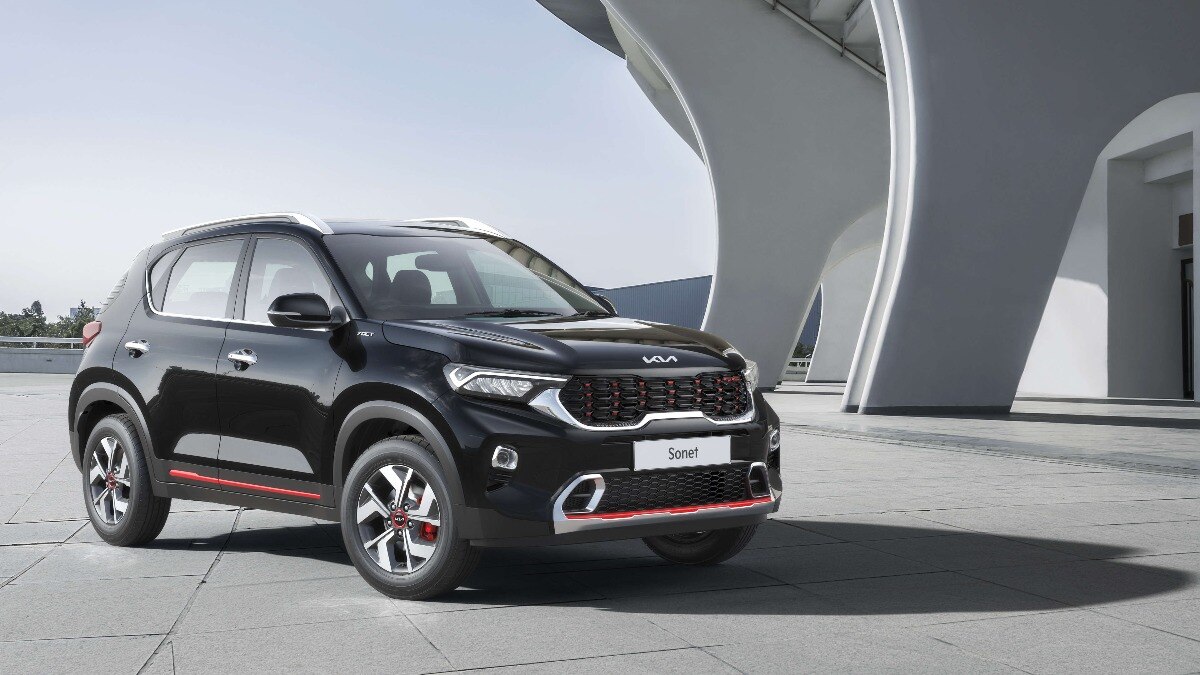Though no one would argue that the Kia Sonet is getting a little dated, it has been on the market for approximately four years. However, we now have a mid-life upgrade that is really substantial. This just serves to highlight how fiercely competitive this market is and how no automaker can afford to take a back seat. As a buyer, you may now get more value for your money than in the past.
Kia Sonet style in 2024
The appearance of this redesigned Kia Sonet is where the biggest alterations are seen. The change in the face is noticeable now. The redesigned lighting with the huge L-shaped trademark and the larger grille with more complex notched detailing are two aspects that contribute to the Sonet’s squatter, broader posture. Quite different from the previous, more rounded appearance.
The Sonet also introduces the X-Line dark-themed trim here, in addition to the Tech Line and GT Line design kits. Similar to the Seltos, these allow for a significant difference between different Sonet iterations. Kia has worked hard on this. The GT-Line and X-Line models come with a completely new, more sculpted bumper that has distinct airdam and foglamp cutouts.
Apart from a more refined selection of dual-tone alloy designs, not much has changed in terms of sheet metal, thus the profile is essentially the same as it was previously. The matte and gloss black paints on the X-Line models are particularly well-chosen, as are the trim materials. However, these will most likely require regular upkeep to maintain their present-day neatness.
The elegant full-width light design now takes centre stage on the back. These are now more than simply decorative elements, and the vertical motif appears to accentuate the presence of this rather small SUV. The exceptionally detailed detailing further enhances the Sonet’s elegant appearance. We think it’s just subdued enough to avoid being garish.
2024 Kia Sonet interiors: ample room and usefulness
The Kia Sonet’s cabin still has the same fundamental design. That means the cascade dash with its big floating instrument panel and its unique vertical air vents is still there. As previously, the overall fit and finish, as well as the tactile operation of the switchgear, give this room a rich sense.
Depending on the version you select, you have varied cabin appointments, much like with the Seltos. Here, the X-Line is heavily themed in a dark manner, with lighter seats and red stitching providing contrast. The beige-black colour scheme of the GT Line is likewise athletic.
The Tech Line’s brown upholstery is new with this upgrade, and it successfully gives the cabin a noticeable boost of richness. Remarkably, we discovered that the flatter Tech Line chairs were a better option than the ridged ones in the GT and X Lines, despite the front seats’ insufficient support for the thigh and lower back. Even so, the sportier trims benefit somewhat from the new motorised adjustability.
The new climate control switches are among the other practical interior upgrades. With their toggle-style arrangement, they now serve a more tactile purpose and blend in better with the overall ambiance of the cabin. The newly installed 10.25-inch digital instrument cluster is another example of such an upgrade. It boasts high-resolution visuals that give the impression that you are driving a much more costly vehicle, and it is readily legible.
Furthermore, the considerate blind-view camera features are quite helpful when driving. The 10.25-inch central touchscreen has also been upgraded to the most recent Kia model, which adds features like Valet mode. However, wireless Apple CarPlay and Android Auto are still unavailable.
The Sonet’s back seat is where you’ll most likely notice that it’s not the widest vehicle in its class. Thus, this Kia fits four persons the best; a fifth would be a tight fit. The front seatbacks have been lowered to help alleviate some of this, while the rear benches have been gently reshaped to provide a little additional thigh support. Thus, knee and leg room are now sufficient for this category, while the chairs’ cushioning and back support still need improvement. You now have a three-point middle seatbelt even if there isn’t a third headrest.
However, the feeling of generosity that comes with the extensive equipment list is still present here. You get sunshades and a one-touch feature for every window. From here, you can also reach the air purifier. In addition to the thoughtfully placed wireless charging pad, practicality is well-taken care of with two Type-C connectors to match the Type-A and C ports and a 12V outlet in the front.
2024 Kia Sonet attributes and security
Complete LED lighting, automatic headlights, sunroof, ventilated seats, 7-speaker Bose audio, paddle shifters, driving and traction modes, tilt steering adjustment, cruise control, and leatherette upholstery are some of the car’s standout features. There’s now a live car tracking option included in the linked features.
Although the new Sonet lacks crash testing, six airbags are now included as standard equipment. In addition, there are TPMS, hill-hold, 360-degree cameras, and the recently introduced set of level 1 ADAS features. We gave this a quick test, and because it uses a camera, we believe it might be a useful tool for maintaining awareness. It’s best viewed as a preventative measure because it’s not the most precise of these systems, particularly in more complicated road scenarios.
Driving impressions and characteristics of the 2024 Kia Sonet
The engine and transmission choices for the Kia Sonet remain same, however a noteworthy change is the recent reintroduction of the diesel-automatic type. The 1.5-liter turbodiesel engine, when combined with a six-speed torque converter, continues to produce 115PS and 250 Nm.
Most people recall their driving experiences thanks to this powerplant, but at this price range, they are becoming less and less common. Although the massive burst of mid-range diesel torque from pre-BS6 vehicles is gone, the low-effort performance that endears diesel cars to their drivers remains. Below 2,000 rpm, there is a slight hesitancy, but not enough to cause problems when driving.
But this Sonet really shines while driving on a highway, when overtaking and maintaining a pace need minimal effort. Although the torque converter isn’t the most vigilant one available, in all but the most extreme driving situations, the readily accessible torque compensates for this. In any case, there seems to be some tendency towards this while utilising the paddles. An other benefit is that noise levels are quite well regulated, especially at lower rpms.
The other engine option stays the same: a 1.0-liter turbo-petrol with 120 horsepower and 172 Nm, mated to either a six-speed iMT or a seven-speed DCT. This motor carries on with its uncomplicated, polite style. Even while it doesn’t have the diesel’s linear mid-range punch, it still feels tractable in traffic since it has more revs to play with.
Nevertheless, before the boost activates in stop-go traffic, the iMT may act a little sluggish. We did observe, though, that compared to the Seltos, using this clutchless manual is more intuitive. On downshifts, it matches revs a little quicker, which makes the operation more like a standard manual.
Nonetheless, we would still choose the dual-clutch. Similar to this Hyundai-Kia vehicle, it is not very fond of abrupt changes, but the additional ratio effectively masks the lag in the engine. Its precisely timed shifts also make driving the Sonet hassle-free in urban and highway environments—as long as you maintain stability. This also applies to the diesel, but in addition to changing the steering and throttle feel, the drive modes also modify the gearbox’s reactions, giving both models a slightly but distinctly more exhilarating driving experience.
The Sonet’s rear suspension has reportedly been somewhat adjusted, according to Kia, but based on our observations, the small SUV still handles and rides remarkably well. Therefore, minor flaws are dealt with appropriately, yet with that strong edge that distinguishes many other Kia products. This implies that bigger cracks or potholes are more apparent. At faster speeds, it gets somewhat better. Though not as much as some others in this sector, the Sonet feels solid here. The diesel with its heavier front-end works better here than the petrol variant.
At these speeds, the steering weights up naturally, but we would have like a little more directness while navigating turns. However, there is a trade-off in that it seems smooth and effortless in urban settings. Once more, the petrol car has a lighter nose than the diesel car, so it can turn corners a little more easily, but the Sonet is still one of the most controlled cars in this class. The more controlled impression is aided by the way the previous setup controls roll smoothly.
2024 Kia Sonet cost and judgement
The Kia Sonet strengthens its position against its numerous competitors with this upgrade. With its makeover, it still seems to be the most appealing luxury option in the small SUV market even if it is no longer the only one. Both the wider list of features and the smarter appearance are helpful. Other benefits include the numerous trim and engine options and the typically enjoyable driving experience.






